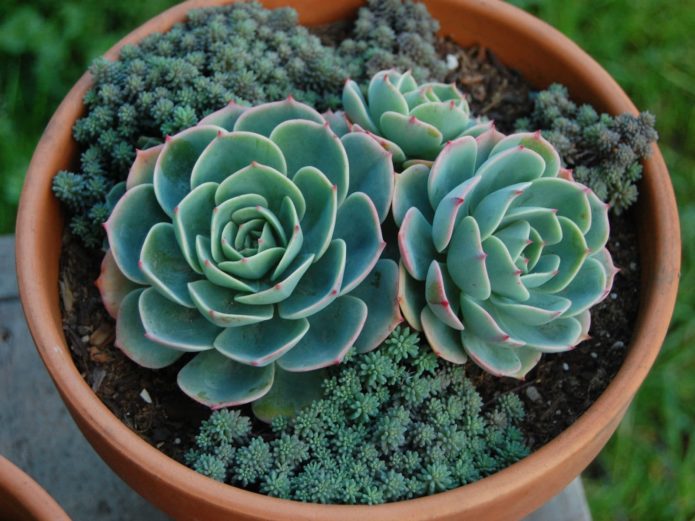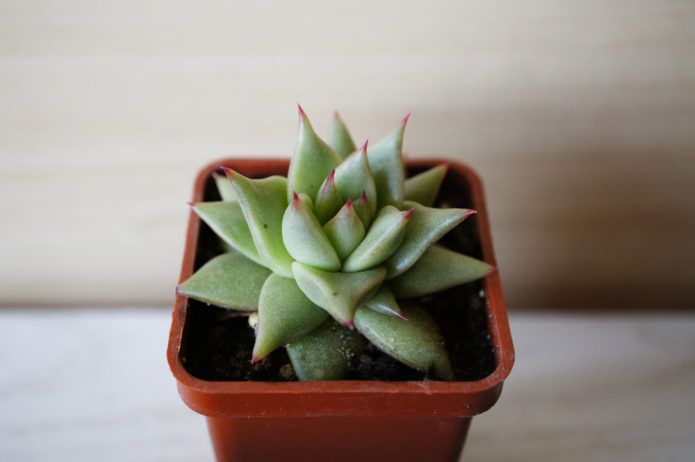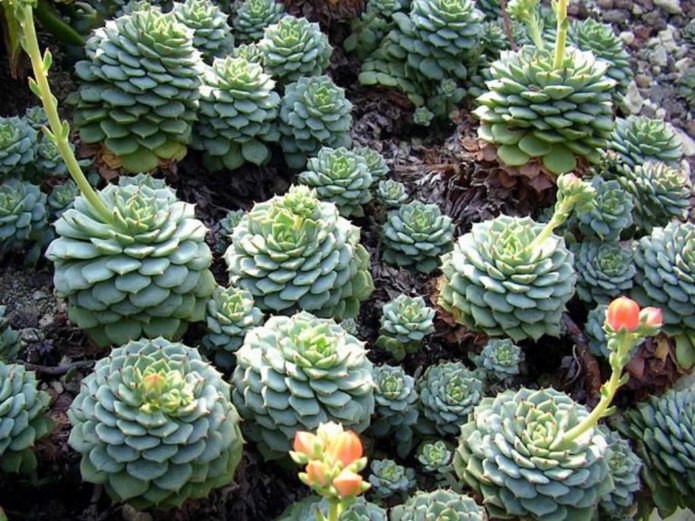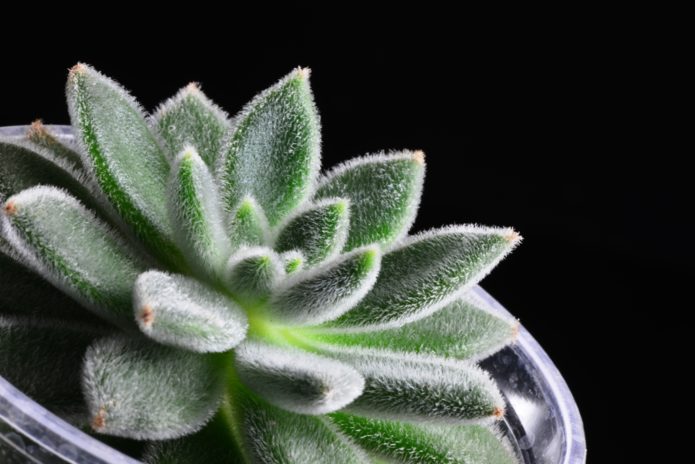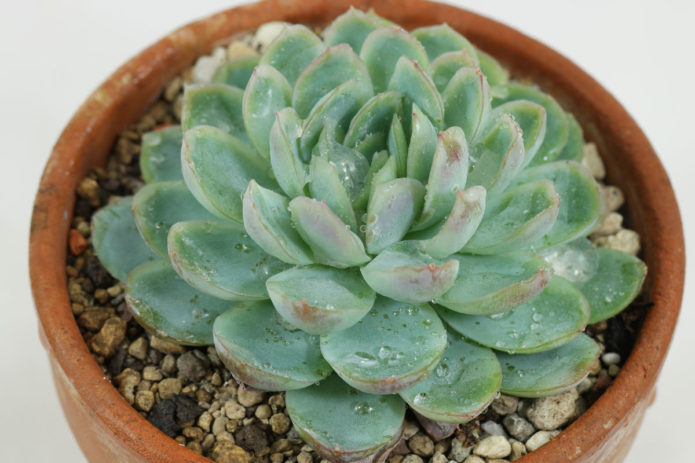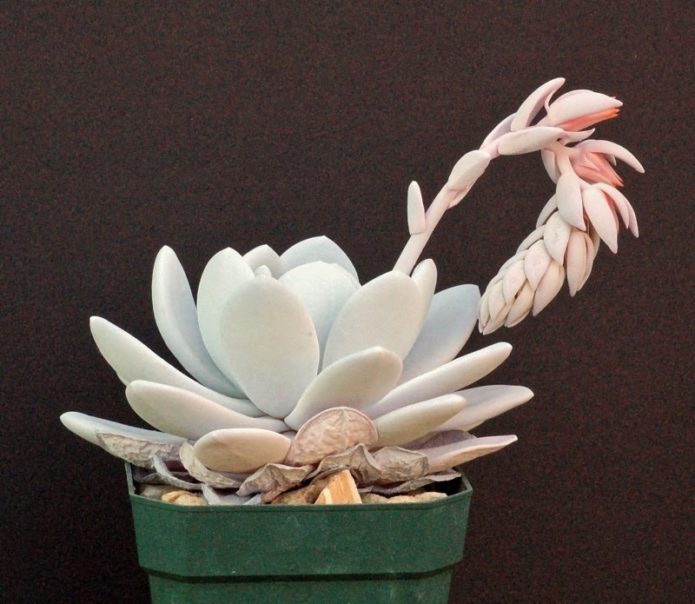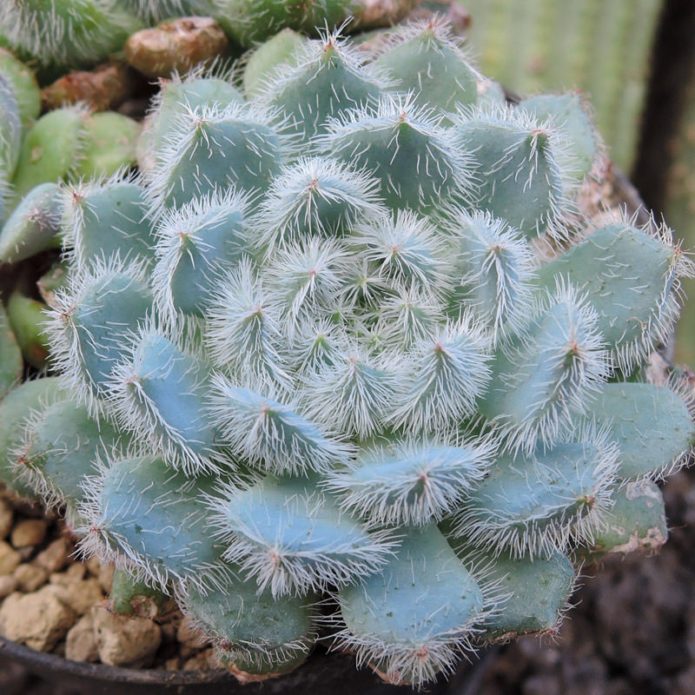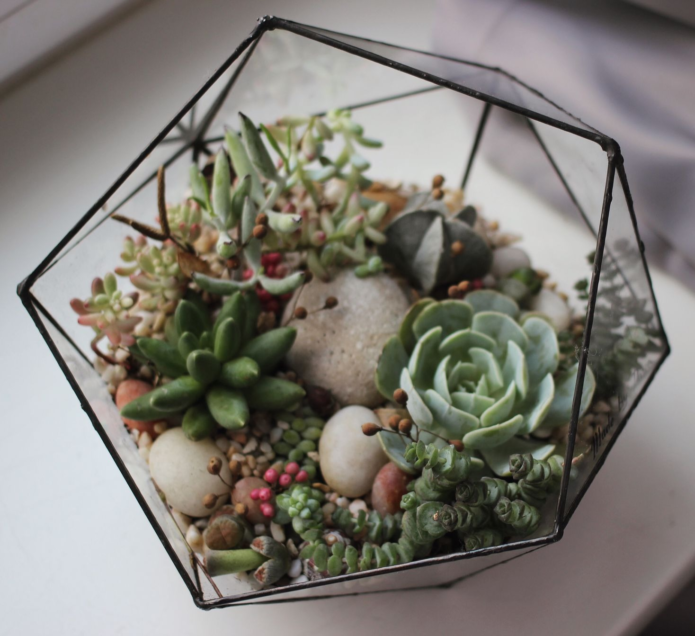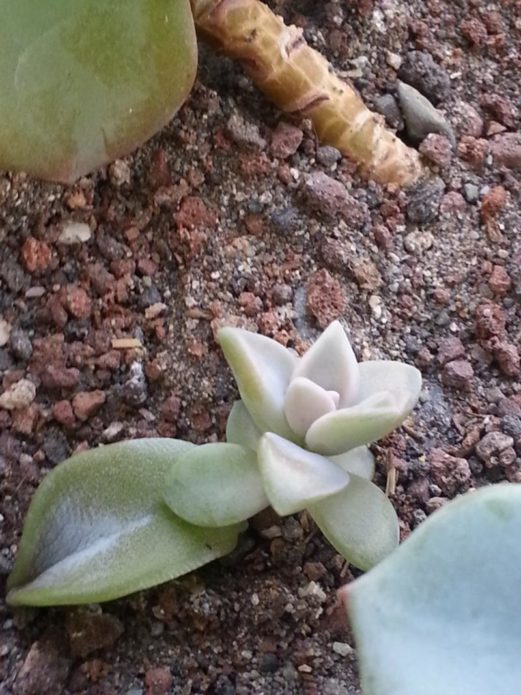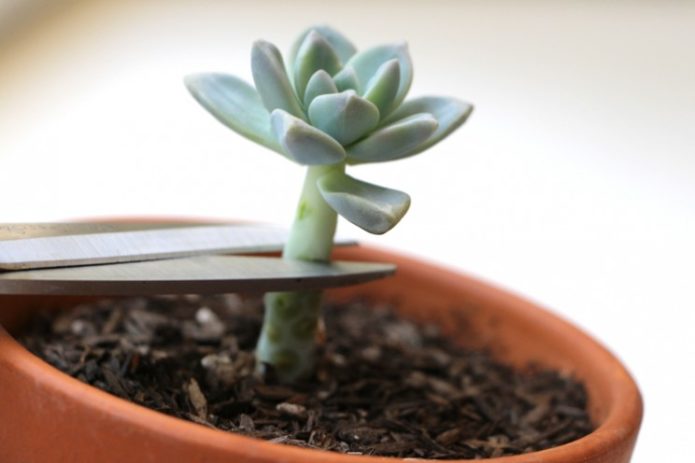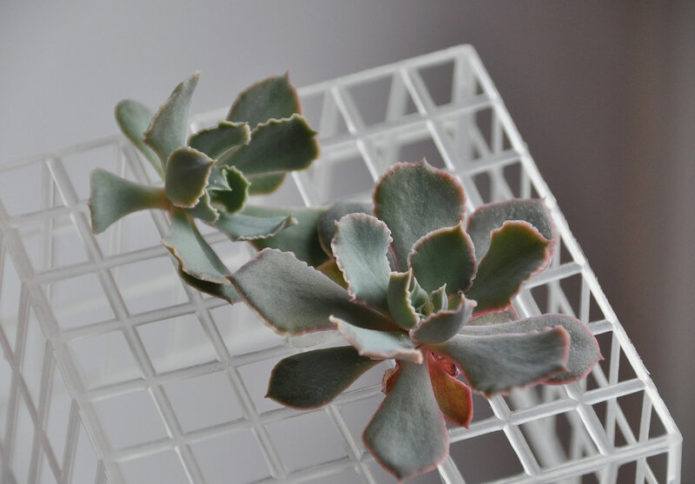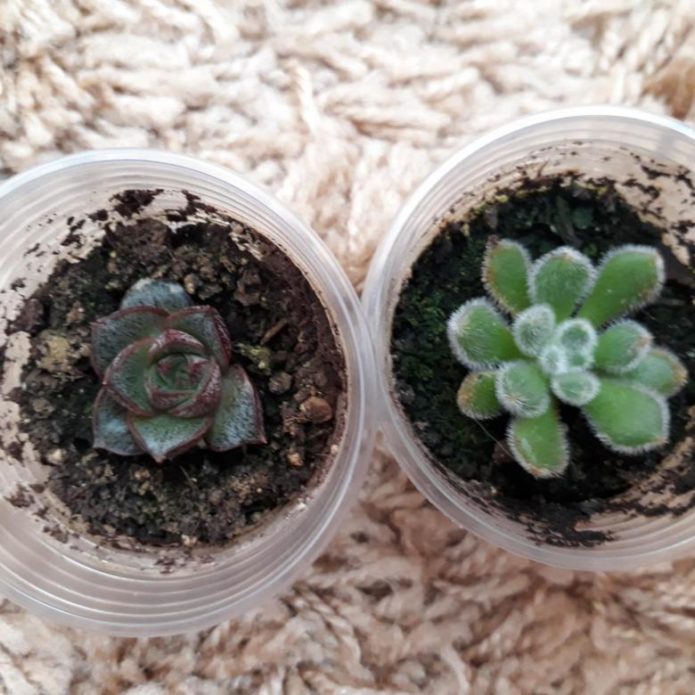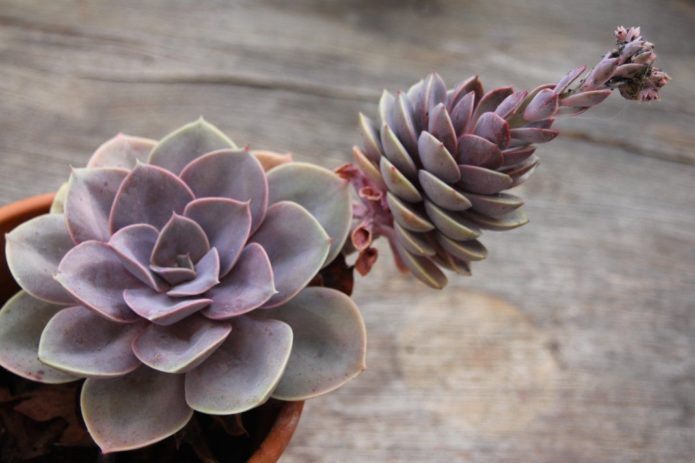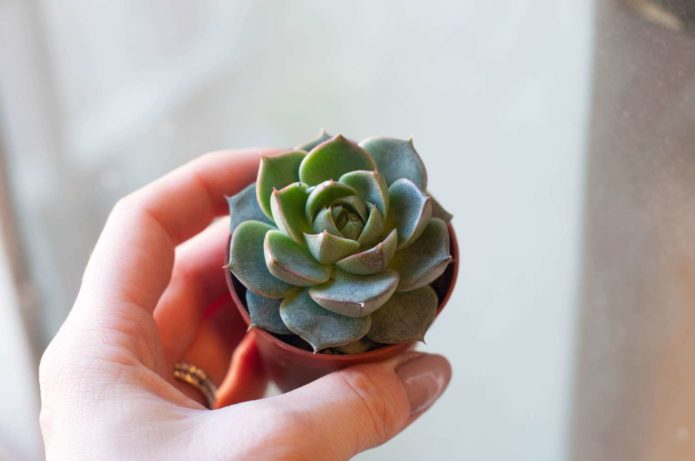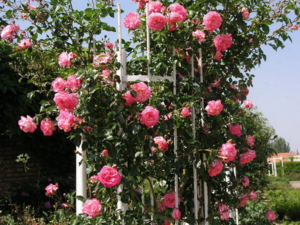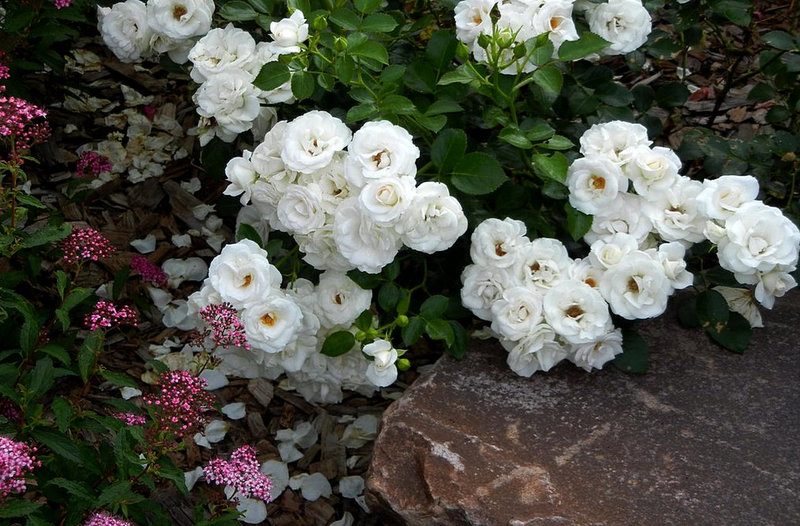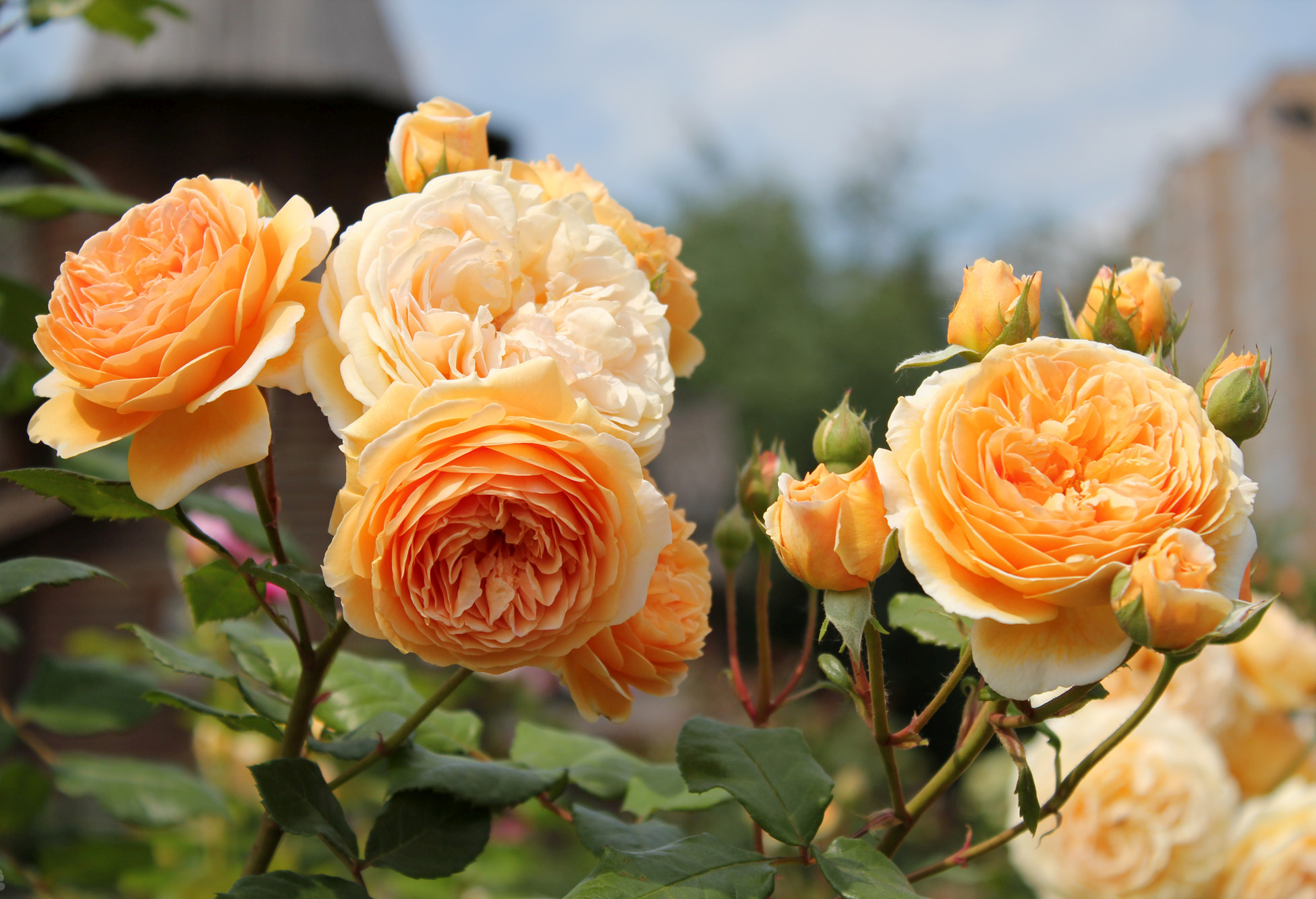Exotic succulent echeveria is an unpretentious but very effective plant. The neat, dense rosettes of this flower seem to be carved out of granite or marble, as if a skillful sculptor had worked on them. For this similarity with the sculpture, Echeveria got its second name - a stone rose.
Content
Differences between echeveria and the plant "rejuvenated"
Echeveria (lat.Echeveria) is a perennial succulent from the Tolstyankov family. The genus is named after the artist Atanasio Echeverría y Godoy, an illustrator of one of the editions of the atlas of plants in Mexico. The plant is a rosette of fleshy leaves filled with moisture. The genus includes species with different shoot length, color and leaf shape.
Because of the visual similarity, this succulent is confused with another plant of the genus fatty - serpervivum, popularly referred to as "young" or "tenacious". But in contrast to the stone rose, the young has thinner leaves and smaller rosettes. The most obvious difference is observed in the process of natural reproduction: Echeveria forms offshoots at the base of the stem, and the young throws out a mustache, and offspring grow on them.
Distribution in nature and habitat
The homeland of the plant is Mexico, where the flower lives on dry rocky soils. This succulent is often found in the wild in North America (from Texas to California) and southern Peru. In the wild, the plant prefers to sit in the bright sun. Thanks to the juicy leaves, the flower easily survives in a lack of moisture.
Signs and superstitions associated with a flower
The plant's ability to withstand long periods of drought and grow in nutrient-poor soils has made this flower popular for cemeteries. Perhaps this is why many people mistakenly believe that some negative energy is in the plant, and it is dangerous to keep it in the house. However, all negative signs about this succulent are not consistent. The energy of the plant is neutral, and it can be safely placed in any corner of the apartment..
Views from photo
In nature, there are about 200 species of plants of the genus Echeveria, but a couple of dozen are used in cultivation. Several types are popular in indoor floriculture.
Agave
The plant is 25–30 cm high, practically without a stem.Leaves are light green with a thin red border.
Derenberg
A species with creeping shoots and pineal rosettes up to 6 cm in diameter. It blooms in spikelets of 4-5 inflorescences.
White-haired
The leaves are thick, rounded, dark green with a silvery pile; as they age, the rosettes reach 20–21 mm.
Graceful
A plant with a flat rosette up to 15 cm in diameter. It consists of bluish leaves up to 5 cm long and up to 2 cm wide. It blooms with pink or bright scarlet flowers.
Lau
The rosette of this species reaches 20 cm in diameter. Light green leaves are covered with a dense whitish bloom, orange-colored inflorescences.
Bristly
Bush type with spherical rosettes. Leaves are dark olive green, long (about 9 cm) and narrow (no more than 3 cm), pointed at the end. The flowers are yellow-orange.
Humpback
A low, upright bush with a tree-like stem and a large-leaved rosette at its top.
Conditions for growing a stone rose
The vegetative period of the plant consists of two seasons: spring-summer - active growth, autumn-winter - dormant period. Each season requires the creation of certain conditions.
Growing conditions for echeveria by seasons: table
| Season | Optimal temperature conditions | Lighting | Humidity | Accommodation |
| Spring Summer | 20 to 25 ° C | Bright, but without direct sunlight on the leaves | Moderate | Balcony, uncovered veranda. From the beginning of summer until September, the plant can be kept outdoors, protecting it from rainwater falling on the leaves. |
| Autumn winter | 7 to 18 ° C | Scattered, but no blackout | Reduced | Any windows except the north ones |
Planting and transplanting
After purchase, the flower must be transplanted into a new soil. But this can be done not immediately, but after 3-4 days, when the plant adapts to new conditions. It is impossible to delay the transplant, since the store soil is poor in nutrients, and the stone rose will soon stop growing.
To maintain decorativeness, adult plants are transplanted every 2-3 years. Young rosettes (up to 3 years old), with an actively growing root system, are recommended to be transplanted annually.
Succulent is grown in wide and flat containers. A ceramic pot is preferable, which allows air to pass well through micropores and does not allow moisture to be retained in the soil.
The plant prefers light, loose soil that does not retain moisture. Ideal for cactus soil with the addition of a third of the volume of fine gravel. When self-manufacturing the substrate, the composition is as follows:
- turf soil - 2 parts;
- sand - 1 part;
- gravel - 1 part;
- charcoal - 0.3 parts.
Before planting, a layer of drainage is placed on the bottom of the pot, which will prevent stagnation of moisture in the soil.
How to transplant echeveria: video
Stone rose in florarium
This plant goes well with other succulents and cacti in the florarium. In a small greenhouse, you can create a real desert landscape by combining various types of Echeveria and the following indoor plants:
- haworthia;
- various types of miniature cacti;
- fat woman;
- lithops;
- Kalanchoe.
To create an original composition, a transparent glass container is filled with soil a quarter of its height, various types of plants are planted with tweezers, then the surface is covered with small stones or colored sand. You can place miniature figures between flowers.
Succulents and cacti do not tolerate humid air, so the florarium is not covered from above. Water the soil in small portions from a miniature watering can.
Watering and feeding
The plant does not tolerate waterlogging of the soil, especially in the autumn-winter period, so watering should be moderate. A new portion of moisture is added to the soil only after it dries out by 3-4 cm. In winter, watering is reduced to 1 time in 1.5 months. Water for irrigation is used settled.
During watering, water should not fall on the leaves and in the center of the outlet: the plant will begin to rot, whitish stains will form on the leaves.
Top dressing is carried out from March to early August. Fertilizers for cacti are ideal for the plant. The amount of fertilizer recommended by the manufacturer is reduced by 50%. The frequency of dressing is every 20-30 days.
Dormant period and flowering features
From late autumn until the end of winter, many plant species are dormant. Flowering depends on compliance with the rules of maintenance at this time... In order for the stone rose to form flower buds, it is kept at a temperature of 15–16 ° C from late December to mid-February. Daylight hours during this period should be no more than 10-12 hours.
At the end of February, the pot is placed on the south window, watered with warm water and the air temperature is raised to 20-25 ° C. This technique helps to awaken the flower buds and they begin to bloom.
Flowering begins at 3-4 years of age. Young rosettes obtained from babies or grown from a leaf do not bloom in 1-2 years of life.
How care errors manifest
This is an unpretentious plant that requires a minimum of attention. But under some conditions, problems arise during cultivation.
Possible problems when growing a stone rose: table
| Problem | Cause | How to fix |
| Gray spots on the leaves | Contact with water leaves during watering | Dry the leaves and prevent moisture from entering them. If water accidentally gets into the center of the outlet, put a piece of napkin to absorb the moisture |
| Pulling the stem. Blanching leaves | Lack of light | Move the plant to a lighter window sill, but shade it in the first 2-3 days: from the excess of the sun's rays, the flower can get sick and die |
| Slowdown in growth | Lack of moisture or nutrients in the soil | Transplant Echeveria into nutrient soil and carry out regular feeding |
| Shriveled leaves | Lack of moisture in the soil. This usually occurs when the air temperature is over 25 ° C. | Move the plant to a cooler place, water for 3-4 days in a row |
| Gray or black plaque on the leaves | Decay of the outlet due to waterlogging of the soil or water ingress into the center. Watering at low air temperatures | Transplant the plant into fresh soil, removing all decayed parts of the root. Increase the air temperature |
Diseases and pests
A stone rose is rarely affected by diseases and pests, but if the rules of care are violated, some types of rot can develop on the plant and pests can multiply.
Diseases and pests of a stone rose: table
| Pest, disease | Signs of infection | Treatment |
| Mealybug | White threads on the leaves that resemble fluff | Spray the outlet with insecticide. In case of severe infection, root the leaves, discard the rest of the plant |
| Root worm | Soft leaves, growth retardation. When infected, the root of the plant is entangled in thin white threads | Transplant the plant into a new pot, replacing the soil. After transplanting 2-3 times with a break of 15-20 days, spray the leaves with an insecticide |
| Gall nematode | Thickening on the roots causing malnutrition of the plant | Cut off the roots with signs of infection, and place healthy ones for 30 minutes. into hot (40–45 ° C) water. Plant the plant in new soil, spray with an insecticide |
| Root rot | Yellowing and dying off of leaves, blackening of roots | It will not be possible to save the plant if it is damaged by rot. Therefore, cuttings are separated from it and rooted to obtain new rosettes |
How to propagate a plant: a step by step description with a photo
This succulent propagates by seed and vegetative means.Sowing seed is used exclusively by breeders to obtain new varieties with unusual decorativeness. For amateur flower growers, vegetative methods of obtaining new plant specimens are advisable: with the upper parts of the rosettes, children or leaf plates.
Leaf propagation
To obtain a new plant, a developed leaf is taken from the bottom of the rosette. It is dried for several hours and slightly buried in a loose substrate.
After 3-4 weeks, the leaf forms mini-rosettes, which are separated and planted in separate pots. The flowering of a plant with this method of reproduction begins after 3-4 g.
Rooting apical cuttings
The plant begins to form apical rosettes in the third or fourth year. For reproduction, the rosette is cut off with a sharp knife and the stem is slightly dried. As soon as the tip of the stem begins to dry out, the rosette is placed on damp soil.
After 20-25 days, roots grow on the stem, and the rosette can be planted in a separate pot.
Planting daughter outlets
Lateral shoots-children gently break off from the main stem with their hands. As a rule, children already have a certain number of roots, so they can be immediately planted in the ground. A young rosette grows quickly and blooms in the second year of life.
Reproduction of a stone rose: video
If you follow the rules of care and treat the flower with love, then this spectacular and not too whimsical plant will delight the owner with its exotic look for a long time.
